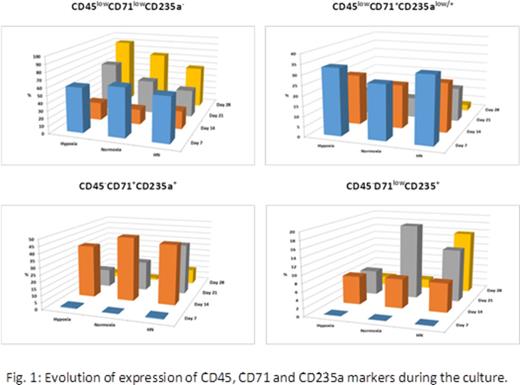Abstract
Erythropoiesis is regulated by microenvironmental factors including bone marrow (BM) architecture, cell-cell and cell-matrix interactions, growth factors, oxygen, etc. Traditional 2D hematopoietic cell cultures require high concentrations of exogenous cytokines and neglect BM architecture which favours formation of niches, including erythroblastic islands, wherein paracrine and autocrine communication occurs. Consequently, these 2D systems do not facilitate the study of erythropoiesis within a biomimetic hematopoietic microenvironment, are costly due to high concentrations of cytokines required, and not scalable. We have previously created a 3D BM biomimicry using porous collagen-coated polyurethane scaffolds for culture of human cord blood mononuclear cells (MNCs) in cytokine-free and serum-free conditions for 28 days. In addition, low concentration (200 mU/mL) of EPO was shown to enhance erythroid differentiation. We now extend our studies to evaluate the role of oxygen and the microenvironmental niches in supporting erythropoiesis.
MNCs were isolated from cord blood and seeded into the 3D system (4x106 cells/scaffold). Serum-free cultures were supplemented with near physiologic concentrations of cytokines: 10 ng/mL SCF (D0-D28), and 100 mU/mL EPO (D7-D28), with medium exchange every 3 days. Three conditions were investigated: normoxia (20%), hypoxia (5%) and 2-step oxygenation (hypoxia from D0-D7 and normoxia thereafter). Proliferation was evaluated in the scaffolds in situ, of the cells released into the supernatant, and of cells extracted from scaffolds at different time-points. Maximum cell expansion was detected in situ at D14 under normoxic (1.6±0.3-fold) and 2-step oxygenation (1.8±0.3-fold) conditions (p<0.05), whereas in hypoxia no significant expansion was detected (0.9±0.2-fold). Erythroid cell maturation was monitored weekly by flow cytometry (CD45, CD71 & CD235a). Hypoxia stimulated faster upregulation of CD235a (34% in hypoxia vs 27% in normoxia of CD45low CD71+ CD235alow/+ cells at D7, which evolve to 34% in hypoxia and 11% in normoxia of CD45- CD71+ CD235a+ supernatant cells at D10, p<0.05). However, normoxia was beneficial for further differentiation (19% in hypoxia vs 41% in normoxia of CD45- CD71low/+ CD235a+ cells at D21, p<0.05). Using the 2-step oxygenation, we combined the early effect of hypoxia with the later effect of normoxia and observed a continuous increase of CD45- CD71low CD235a+ cells from D14-D28. At D28, both normoxia and hypoxia showed a renewed population of early erythroid progenitor cells (90% in hypoxia and 74% in normoxia of CD45low CD71low CD235a- cells) but little terminal maturation (6% of CD45- CD71low/+ CD235a+ cells in hypoxia and 4% in normoxia), whereas 2-step oxygenation displayed enhanced erythroid maturation and an early erythroid progenitor population (25% of CD45- CD71low/+ CD235a+ and 57% of CD45low CD71low CD235a- cells, p<0.05, fig.1), which may enable the continuous self-renewal of the culture. Clonogenic capacity of the extracted cells from the scaffolds was assessed weekly. BFU-E and CFU-E were predominantly present in the first 14 days (127±30 BFU-E in normoxia and 200±42 in hypoxia at D7, which progress to 58±19 CFU-E in normoxia and 22±7 in hypoxia at D14), confirming propensity towards erythroid lineage commitment and the critical time-period for erythropoiesis within the first 14-21 days. Cells positive for STRO-1, osteopontin and vimentin were identified in situ by confocal immunofluorescence microscopy. CD68+ cells were also detected in proximity to CD71+ cells suggesting formation of erythroblastic islands. Niche-like structures were also observed in situ by scanning electron microscopy at D17 & D25, suggesting the creation of physiologic erythroid niches with the presence of stroma-like cells. SCF and EPO concentrations were measured using ELISA; EPO was detected at D4 in hypoxia (0.8±0.5 ng/mL) and D7 (2.7±0.7 ng/mL in normoxia; 3.0±0.5 ng/mL in hypoxia), prior to addition of EPO to the cultures suggesting endogenous production. From D4 to D7, consumption of SCF was 2.9±0.5 ng/mL in hypoxia; no consumption was detected in normoxia.
The 3D BM biomimicry with near-physiologic oxygen and cytokine concentrations was suitable in reproducing physiologic erythropoiesis for further study. Early stage hypoxia with late stage normoxia enhanced and extended erythroid production.
No relevant conflicts of interest to declare.
Author notes
Asterisk with author names denotes non-ASH members.


This feature is available to Subscribers Only
Sign In or Create an Account Close Modal